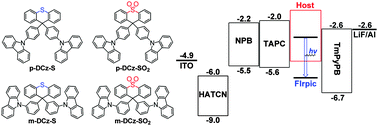9,9-Diphenyl-thioxanthene derivatives as host materials for highly efficient blue phosphorescent organic light-emitting diodes†
Abstract
A series of 9,9-diphenyl-9H-thioxanthene derivatives with different valence states of sulfur atoms are reported as host materials in blue phosphorescent organic light-emitting diodes. Their photophysical, electrochemical and thermal properties, as well as device performance were thoroughly investigated to study their structure–property relationships, including the different carbazolyl linkage positions and valence states of sulfur atoms. Extremely low turn-on voltages of around 2.6 V for blue electrophosphorescence, which are already corresponding to the value of the emitted photon energy (hv)/electron charge (e), were achieved by utilizing the developed materials as hosts of the blue phosphor dopant iridium(III)bis(4,6-(difluorophenyl)-pyridinato-N,C2′)picolinate (FIrpic). Notably, a maximal power efficiency of 69.7 lm W−1 and an external quantum efficiency of 29.0% were achieved for an optimal device based on m-DCz-S consisting of the bivalent sulfur atom and meta-combined carbazolyl.


 Please wait while we load your content...
Please wait while we load your content...